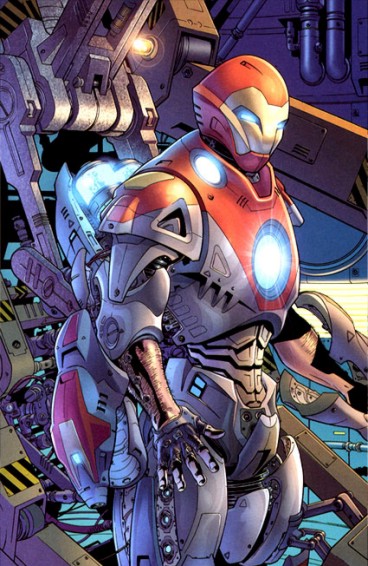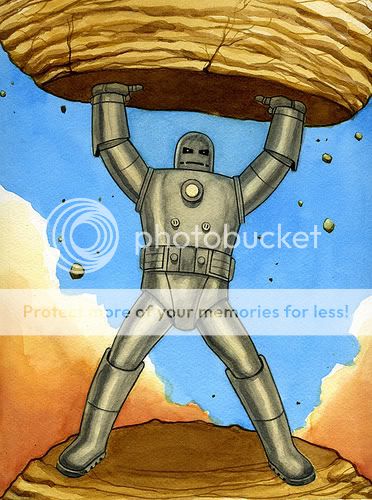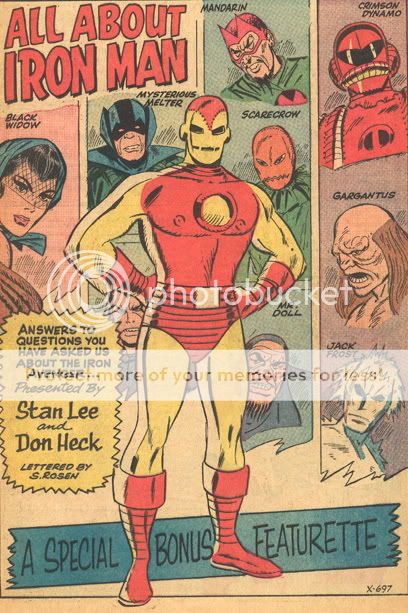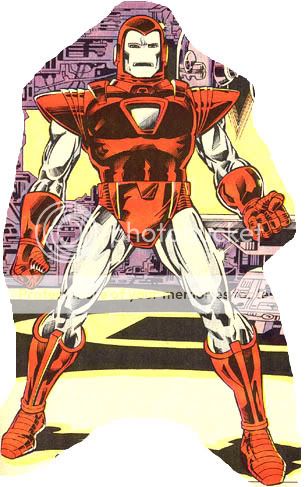Space
First Appearance:
Iron Man (Vol. 1) #142
While based on the same design principles, this suit's matrix was formed non-collapsible to increase its protection from the rigors of deep space; also, its specialized nature made collapsibility unnecessary. Power was provided by a Mk IV micro-nuclear supply pack, supplemented by solar power converters. Systems were controlled via a cybernetic interface, though it proved to be overly sensitive; when Stark first used the armor he had difficulty triggering the appropriate command to activate the feature he wanted. The suit was designed for extended time outside of the atmosphere, up to two days in orbit (food and catheterization capable). The life support, boot jets and altitude maneuvering were powered by an on-board supply of liquid oxygen. Weaponry consisted of palm-mounted third-generation
Repulsors (electron beams which require laser ionized path of air to travel through the atmosphere; the beam is moderated using a pulsing beam and early form of adaptive optics; objects are jolted away from the beam path by the combination of ionized air and the accelerated neutron beam) and a chest-mounted
Unibeam (a variable intensity light source usable as a spotlight or a laser; the pentagon shape of the emitter allowed for more accurate laser pulsing while in an atmosphere), and epaulet-mounted concussion-burst cannons. Sensors consisted of radar, sonar, infrared scanners, and radio. Additional features included ECM against radar and sonar, and the fully articulated hands could be fired out on retractable cables for use as long-range grapples. The most obvious feature on this special armor was its ability to attain escape velocity without aid of an external thruster, unique to this Iron Man version; however, the nuclear jets which allowed this made the suit bulky, heavy and awkward in Earth's gravity. The dangers inherent in an atomic-energy based propulsion system of such immense power seem to have driven Tony Stark to build the thruster unit which he has been using ever since. A new space armor was created later on, intended to function for weeks on end without maintenance, recharging or restocking of resources. It was able to evade the sophisticated sensors on Kree and Shi'ar spaceships as well as interface with their technology. It also possessed an extremely powerful self-destruct mechanism via its fusion reactor.
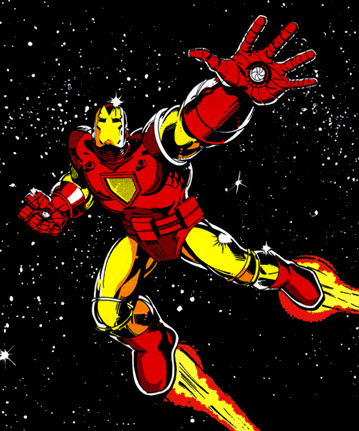
Stealth
First Appearance:
Iron Man (Vol. 1) #152
The Stealth armor is another of the specialized suits of armor developed by Tony Stark for specific missions, similar to the Space Armor; indeed, its creation was inspired due to him being tracked by radar during his use of the Space Armor. The Stealth Armor was designed using current "stealth" technology to allow Iron Man to foil detection devices and slip unknown in and out of restricted areas. This sleek, jet black suit (composed of impact resistant carbon-composites overlaid on top of layered "flex-metal" which can condense itself like a 3-dimensional accordion pleat) was a polarized metal mesh armor that uses every bit of space for detection and evasion components, and therefore was originally designed with no weapons. Most of this armor used solar power to charge the batteries and run most of the integrated circuitry, though the pods on the sides were batteries that could maintain the suit's functions for a short time. It was able to recharge itself from electrical sources, a thermocouple to siphon power from extreme heat or cold, and solar power. The suit utilized force field technology to render Iron Man electronically invisible- a layer of low density plasma would be held in place by a focused magnetic field, and the tripole waveform reflected radar, along with a wave modifier that bent the radar around it. To quash any detectable infrared signature, the armor's boot-jet exhaust was "washed" by bursts of super-cooled air. The micro-turbines on his jet boots possess assisted air liquification devices, rings of liquid oxygen jets, that cool the boots' emissions. The Stealth Armor was later upgraded with a manually-controlled camouflage effect that provided the wearer with invisibility to visual or camera detection, but only against backgrounds that are mostly of one color. Another addition was the palm-mounted Mk IV Repulsors, though they only had enough energy to fire three shots at full power. Tony's Mark III Stealth unit was specifically designed to combat the Black Panther's anti-metal vibranium claws- it is composed entirely of advanced composite ceramics and experimental bio-neural gel-pack circuitry, fused with a kevlar-like polymer and backed by optical fiber networks; all of which comes down to an armor which was invisible to electronic detection systems as well as the naked eye, even the Black Panther's. Although the development of Stark's new cloaking technology for the Mark 25 "S.K.I.N." armor probably rendered the Mark III unit's stealth technology obsolete, the Mark III Stealth armor is nevertheless an effective weapon against opponents such as the Black Panther and Magneto because of its plastic/ceramic design.

Silver Centurion
First Appearance:
Iron Man (Vol. 1) #200
Stark began creating the Silver Centurion armor as a method of working out ideas and experimenting. The S-circuit, which uses its energy more efficiently, is an example of the breakthrough developed by Stark, using the armor as a model. With the destruction of Circuits Maximus by Obadiah Stane, Stark donned the newest set of armor to battle the foe that stripped him of his business, his friends, and almost his life. The battle with Stane was the first field test of this armor, and resulted in the defeat of Stane and the destruction of Stane International. The suit had a rigid interior and a 3-D knitted metallic exterior, providing protection from physical attacks as well as acid, heat, cold, most forms of energy, radiation, and electricity. A 3-D knitting pattern on a submolecular construction level gave the armor itself more strength, while allowing for the most comfortable suit interior. By expanding the field that keeps the armor rigid, the armor could encase itself in a protective force field that was effective against most forms of attack; Stark could also use this field to polarize the armor to either attract or repulse other items via magnetic polarity. Most of this armor used solar power to charge the batteries and run most of the integrated circuitry, though the pods on the sides were batteries that could maintain the suits functions for a short time. It was also able to recharge itself from electrical sources, a thermocouple to siphon power from extreme heat or cold. Flight was accomplished via Mk IV boot-jets (which incorporated high-speed duo-source turbines), supplemented by a booster pack that enabled the armor to attain speeds up to 750mph in the air and 180mph in the water. Weaponry consisted of a chest-mounted Mk III Unibeam (search light, heat beams, tractor beam, laser beam, and ultraviolet light beam), palm-mounted Mk III Repulsors (laser-guided particle beam emitters), pulse bolts (slow-moving high energy plasma discharge "torpedoes" that build in intensity as they travel through the atmosphere, picking up static and ambient energy and thus doing more damage the farther they travel), and a sonic emitter (generating high-frequency sound waves). Sensors consisted of a full band audiovisual transceiver, radar, sonar, infrared scanners, and an electromagnetic scanner that could, by measuring the variances in the magnetic fields in structures, reverse-engineer a schematic of the layout where power lines ran inside of the walls and overlay the layout onto the visual display inside the helmet. The suit also had power cords in his belt that he could connect to any kind of power conduit and siphon that energy to add to his reserves. One notable feature of the suit was the hologram emitter, which could generate up to 12 simultaneous images of the armor. It could also be used to generate a "chameleon field" around itself; the computer in the armor would analyze its surroundings and generate a hologram to make it blend in with the surroundings making it effectively invisible visually and to cameras. Unfortunately, the "chameleon effect" module interfered with the cybernetic controls of the armor, providing nasty feedback and massive headaches. The Silver Centurion armor- or at least a copy of it, given that the original was destroyed towards the conclusion of the
"Armor Wars"- was recently used by Tony Stark to defeat the Mandarin, when his Extremis abilities were temporarily deactivated due to concerns regarding his mental health.
Hydro
First Appearance:
Iron Man (Vol. 1) #218
This unit was designed for salvage missions at the bottom of the deepest oceans -- while Stark's conventional suits function underwater, they were noisy, inefficient, and they leaked. The exact composition is unknown; it is assumed to be composed of the same layered "flex-metal" micro-scale suit tiles fabricated by genetically engineered metal-affinity bacteria which assemble themselves in specific orderly arrays and then expire, leaving behind various metallic deposits which form all the metal shapes and micro-electronic circuits. A new aligned-crystal production process allowed the construction of a large, semi-spherical headpiece, as transparent as glass. This unit possessed several ocean-specific weapons, such as the electric field of an electric eel, a camouflage 'ink cloud' and small 'manta ray' torpedoes. It also comprised an inner "Escape Suit" that could be jettisoned from the main suit in case of emergency (this inner suit possessed a Unibeam, 2 torpedoes, and the holding bay). Functions were controlled by cybernetic interface.
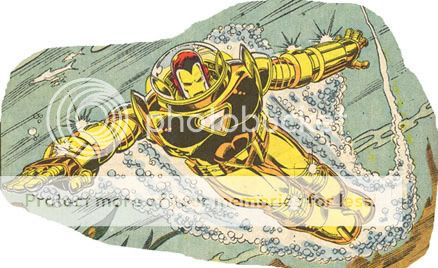
Neo-Classic
First Appearance:
Iron Man (Vol. 1) #231
During the Armor Wars, Iron Man found himself facing the government-sanctioned armored assassin Firepower. Against this walking, flying armored arsenal, even the Silver Centurion armor did not stand a chance, and it was destroyed. Reluctant to enter the fray again, but forced into action, Tony Stark designed a new suit, even more powerful and versatile than its predecessor, designed specifically to negate Firepower's original advantages, such as a means of disrupting Firepower's targeting systems, a gauntlet-generated energy shield, and more powerful boosters for increased speed. It made short work of Firepower, and Stark was so horrified of the destructive potential of the armor should it fall into the wrong hands, he resolved to destroy it. Fortunately, he changed his mind. The neo-classic armor resembled the classic armor which had endured for many years, with some minor cosmetic changes. Its appearance changed somewhat, mainly becoming more bulky, ostensibly to increase thruster power (its massive boot-jets earning it the some-time nickname "coffeepot armor"). It was also the first armor to incorporate a beta-particle generator, radically reducing Iron Man's external power needs and boosting his already formidable might.
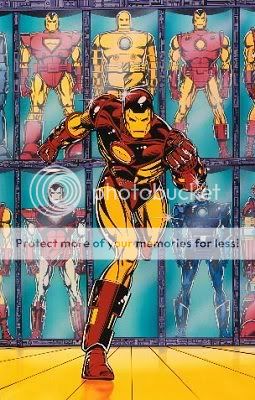
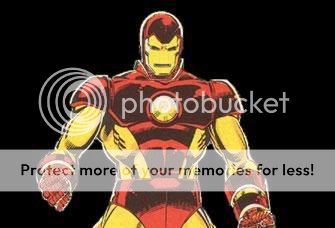
War Machine
First Appearance:
Iron Man (Vol. 1) #281
This suit was created initially by Stark to deal with the Masters of Silence threat; a later version, JRXL-1000, was designed and built for, and worn for a while by James Rhodes. It was designed for all-out warfare, and was also known as the
"Variable Threat Response Battle Suit." It was not collapsible, and included far heavier carbon-composite-based armor as well as improved tactical computer systems and automatic targeting. Since the Masters of Silence were protected against Iron Man's usual weaponry (Repulsors and Unibeam), those weapons were removed from the first version of the armor. In both iterations, the shoulder mounted weapons are modular and can be removed and replaced. In the first version, both the double-barreled cannon and the laser blade were fixed (the flamethrower was built over the laser blade casing). In the Rhodes model, the wrist weapons became modular too.



